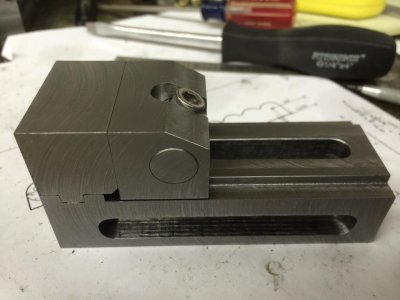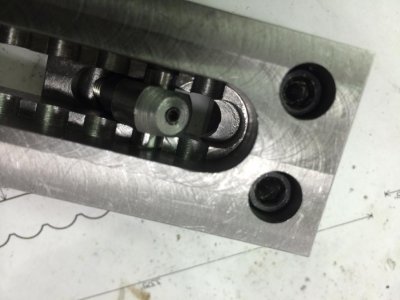Using some of the ideas from the video David posted above I took another look at the vise. As far as I can tell the bottom is reasonably flat, and the sides are as square to the bottom as I could hope (checked with my machinist squares (which also seem reasonable square)). The top side of the vise (which the movable jaw rides on) is square to the sides, reasonably flat, and indicates parallel to the bottom. However, the back of the vise (rear side of the fixed jaw) is not 100% square to the bottom. I would say it's out by about .003 over 2". The faces of the jaws are also visibly out of square with the top of the vise (using the square and looking for light). I could see with the back out of alignment that the jaw faces could have been milled parallel to the back (as it was the side against the fixed jaw on my mill vise when I faced the jaws last), what is odd though is that both the fixed and movable jaws are "out" about the same amount, but in both cases the top edge shows the gap (with the square on the "top" side of the vise... Not certain how the movable jaw got cut basically the reverse of the fixed jaw unless the mill was slightly tapered as well?
Anyway, I was going to fix the rear face of the vise. But after indicating my mill vise to ensure it's fixed jaw was still true (in both X and Z axis), when I placed the little vise in the mill vise (back side up, bottom against the rear jaw, sitting on short parallels, with a piece of copper wire between the movable jaw and the "top" of the small vise, the top surface (back of the small vise) indicated it was flat? I ran the flycutter across it anyway, taking almost no cut, and the cutter touched everywhere the same amount (almost nothing, just enough to mark the surface). The only thing I can think is that the combination of only clamping only the last inch of the small vise bottom, and it sticking out of the mill vise 3", and potential jaw lift in my mill vise (it's a Chinese vise, not a Kurt) is introducing enough tilt that I'm left with the vise being held slightly out of straight...
After that I decided to go ahead and give hand working the jaw faces a shot. I used the squares against the top side of the vise, and started hand filing the faces of the jaws. After maybe a half hour of slowly working them I was left with this:

The faces read square to the top side of the vise (which indicates parallel to the bottom of the vise), there is no visible crack between the faces (I can see no light between them) and I can't fit my smallest feeler gauge (.0015) between the faces anywhere. I was careful not to make the faces concave so they aren't just touching around the edges. Anyway, I'm pretty pleased with the results - not what I would have expected, that hand-working with a file would be more "precise" than using the mill, but that's what I discovered...
I also had to make one final tweak to the design to make the "retainer slot" closest to the fixed jaw end of the vise usable. I had to mill out a little extra space to make room for the pivoting grabber-thing...

I'll probably take a shot at squaring up the back of the vise with the files. And I'm planning on making a dedicated wrench for tightening it. But other than those, I think this project is basically done.
Thanks for the input along the way!






